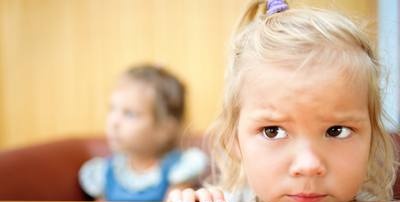|
 This review will establish the systematization of problems and disorders of interpersonal communication in childhood. How to find out and diagnose the real causes of conflicts? How to try to fix it, get it back on track? This review will establish the systematization of problems and disorders of interpersonal communication in childhood. How to find out and diagnose the real causes of conflicts? How to try to fix it, get it back on track?
Communication with peers has its own characteristic features:
1. Especially bright emotional saturation.
2. The non-standard nature of children's statements.
4. Communication with a peer is much richer in purpose and function.
Difficulties of preschoolers in relationships with peers most often arise for the following reasons:
1. Actual trouble in the development of the child.
2. Aggressive children with poor control over their behavior.
3. The early stage of character formation and, in particular, its accentuations.
4. The child does not know how to communicate, play and interaction skills are at a low level.
5. The child does not want to communicate, because in any communication and interaction, you must control yourself.
6. Unwillingness to communicate with peers due to the individual characteristics of the child (shyness, low self-esteem, insecurity).
7. The predominance of the child's selfish motives in behavior.
We often encounter conflicts in the sphere of interaction between children of different ages and with peers.
Children's conflicts are divided into:
- intrapersonal;
- interpersonal;
- intragroup.
According to the form and degree of collision, children's conflicts are divided into:
- open (dispute, quarrel);
- hidden (surreptitious actions);
- spontaneous;
- intentional.
 The main causes of children's interpersonal conflicts: The main causes of children's interpersonal conflicts:
1. Incompatibility of characters.
2. Clash of motives, needs, interests.
3. Intrapersonal contradictions.
4. Rivalry (competition).
The resolution of children's conflicts largely depends on the teacher's ability to notice in time the moment when disagreements and discomfort develop into a conflict situation.
The main methods of conflict management include:
1. Intrapersonal, i.e. methods of influencing a certain person. These methods consist in the ability to properly organize your own behavior, to express your point of view.
2. Interpersonal methods.
In order to carry out pedagogically correct management of children's relationships, it is necessary:
1. Know the sociometric status of the child.
2. Know the individual characteristics of each child (type of temperament, personality traits).
3. To know how the relationship of children in a team is developing (whom the child imitates, whom he prefers, whom he influences, the characteristics of relationships and the distribution of roles in family, value orientations of parents).
To identify violations in the relationship of children with each other, the following methods are used:
1. Observation.
2. Diagnostics of interpersonal relations based on subjective preferences (sociometric methods: "Secret" (T. Repina), "Two houses" (T. Martsinkovskaya))
3. Diagnostics of interpersonal relations of children in play using Bulatova's methodology.
4. Symbolic modeling of a real situation.
5. Projective techniques: “My friends”, “I and the group”, “Home. Wood. Man ”,“ Drawing of a Tree ”.
6. Color test of Luscher's relationship.
7. Color test of relations Semago.
8. Test of childhood anxiety R. Taml, M. Dorkey, In Amen.
9. Test of children's apperception (SAN).
10. "Ladder" technique
11. “Finish sentences” technique (children's version of V. Michal).
12. Graphic conversation "My social circle".
Analysis of the diagnostic results allows us to form groups of children for further correctional work:
Group 1 - “Fears. Anxiety"
Group 2 - "Aggressiveness"
Group 3 - "Communication skills"
Proceeding from the fact that the phases of a child's social development are associated with the formation of mechanisms of personal growth, corrective work with children should be built on the basis of the sequence in which the latter emerge.
Each mechanism of personal growth is formed in the process of a certain type of child's relationship with the social environment - accordingly, psychocorrectional measures are constructed in such a way as to preserve the natural sequence of their occurrence and to simulate the type of relationship characteristic of the emergence of mechanisms.
The formation of emotional responsiveness can be carried out not only in correctional classes, but also in the process of regime moments, in the free activity of children, during physical culture and music lessons, and general leisure. Conducted subgroup, group and individual lessons should be aimed at the formation of positive self-esteem and a favorable psychological climate in the group, the ability to recognize their own emotional state and the mood of a peer, even if it is difficult child, to see in him the reason for his own and others' behavior, mastering the skills of arbitrary regulation of behavior and the formation of the internal position of the individual.
The goal setting for each lesson varies in various combinations:
• increasing the activity of mental processes: thinking, memory, speech, attention, perception;
• development of the child's emotional sphere (stabilization, development of positive perception);
• communication (expansion of the behavioral repertoire, development of communication skills);
• personality (improving self-esteem, working with impairments).
Inna Ivolgina
|
 This review will establish the systematization of problems and disorders of interpersonal communication in childhood. How to find out and diagnose the real causes of conflicts? How to try to fix it, get it back on track?
This review will establish the systematization of problems and disorders of interpersonal communication in childhood. How to find out and diagnose the real causes of conflicts? How to try to fix it, get it back on track?




